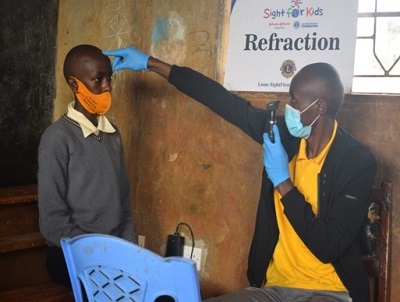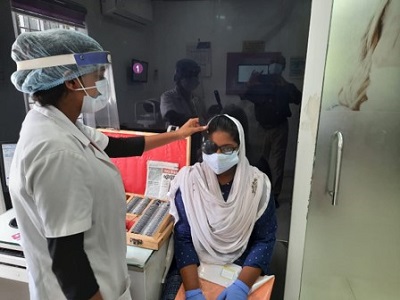Children can act out in school for many reasons. Some of these reasons may be more obvious than others, but sometimes the solution is as simple as needing eyeglasses. Unable to see the blackboard or their books, sometimes children lash out and are moved to the back of the classroom, where the problem only becomes worse. However, Sight For Kids® has been training teachers across the globe that children can act out because they may be having trouble with their vision. The program aims to identify these visually-impaired children sooner.
Sight For Kids is a longstanding collaboration between Johnson & Johnson Vision and Lions Clubs International Foundation (LCIF).
Sight For Kids is a longstanding collaboration between Johnson & Johnson Vision and Lions Clubs International Foundation (LCIF). In 2002, these two organizations established Sight for Kids, a school-based global eye health program that mobilizes Lions to provide access to eye health education, vision screenings, high quality vision examinations, spectacles, and referral access to professional eye care and treatment. To date, more than 42 million children around the world have been helped through the program.
Sight For Kids in Kenya
In Nairobi, Kenya, one boy was just four years old when Dr. Tanvi Shah diagnosed him with congenital cataracts in both of his eyes. When Dr. Shah told the boy’s mother about his condition, his mother broke down crying. How could she afford eye surgery when she couldn’t afford shoes or a new school uniform for her child? Luckily, the boy was the perfect candidate for Sight For Kids. His story is that of many children who now have the gift of sight thanks to the Sight For Kids program.
 Dr. Shah is one of many optometrists who helps children in need through the program. She is the Sight For Kids project chairperson at the Lions SightFirst Eye Hospital in Nairobi. Dr. Shah has been interested in vision care ever since she helped her grandfather, who had vision problems, read the newspaper. “As a young girl, I always told [him] that when I grow up, I'm going to be a doctor who's going to be able to help [him] see. So, as I grew older, I started reading about his eye condition and started developing an interest in vision and eyesight. And this is how I landed in the field of optometry,” says Shah.
Dr. Shah is one of many optometrists who helps children in need through the program. She is the Sight For Kids project chairperson at the Lions SightFirst Eye Hospital in Nairobi. Dr. Shah has been interested in vision care ever since she helped her grandfather, who had vision problems, read the newspaper. “As a young girl, I always told [him] that when I grow up, I'm going to be a doctor who's going to be able to help [him] see. So, as I grew older, I started reading about his eye condition and started developing an interest in vision and eyesight. And this is how I landed in the field of optometry,” says Shah.
She also admits she is inspired by children in her work. “I really enjoy helping people who need assistance in whatever way possible, and I always have a soft spot for children. I love helping them grow into happier people,” Dr. Shah says.
As head of the Sight For Kids program in Kenya, Dr. Shah is intimately familiar with their mission. “It’s a team effort,” she says. Dr. Shah explains the following components are all critical to the program:
- Teaching training for pre-screening
- Parent engagement
- Eye examinations by trained professionals
Altogether, Dr. Shah and the Lions have made an impact in the lives of many Kenyan children and their families.
Sight For Kids in India
Kenya isn’t alone in recognizing the importance of teachers in the Sight For Kids program. According to Dr. Freddy Simon, an ophthalmologist in Kerala, India who treats children through Sight For Kids, getting teachers involved in the pre-screening process is a critical part of the process. Dr. Simon says, “Teachers have a unique position because they can notice things from the kids that parents cannot.”
 Dr. Simon is also inspired by the children. He says, “I treat adults and children, but the satisfaction I get from treating children is, I feel, slightly more because they have their whole lives [ahead of them]… For children, we change a lot of things, we change their careers, we change their studies. We are giving them a leg up in life.”
Dr. Simon is also inspired by the children. He says, “I treat adults and children, but the satisfaction I get from treating children is, I feel, slightly more because they have their whole lives [ahead of them]… For children, we change a lot of things, we change their careers, we change their studies. We are giving them a leg up in life.”
Dr. Simon explains in the year before the pandemic, approximately 650,000 kids in India were examined by teachers. Teacher screenings through Sight For Kids ultimately led to the identification and treatment of 9,588 Indian children in need.
Sight For Kids During the COVID-19 Crisis
COVID-19 hit the world hard, but Sight For Kids continued pushing forward. Back in Kenya, Dr. Shah says, “It’s heartening to note we’ve now found innovative ways to run this program safely for children in these challenging times. Of course, due to the lockdowns and restrictions, it has been a challenge for us to reach out to the schools. However, we have kept all hospital doors open to the parents who wish to bring their children to us, and we continuously encouraged the teachers to speak to the parents as well, to refer the children here.”
In India, during the COVID-19 crisis, Dr. Simon says that they were only able to see children in small batches, but still distributed the same number of glasses in 2020 as the year before the pandemic hit. This was in large part due to the close collaboration with the State of Kerala Government in India.
Both Drs. Shah and Simon agree it is critical to reach children as early as possible, and the younger the better. Vision has a unique developmental trajectory, and childhood is a critical period for vision development. Thanks to these collaborations between Lions, teachers, government, and vision healthcare providers like Drs. Shah and Simon, Sight For Kids is creating a vision for a better future – one child at a time.
LCIF is proud to have partnered with Johnson & Johnson Vision to implement the Sight For Kids program. Visit lionsclubs.org/SFK to learn more about how we are transforming vision care through comprehensive eye health solutions.
The coronavirus (COVID-19) pandemic has impacted communities around the world in different ways. To ensure we’re serving safely wherever we live, Lions should follow the guidelines of the Centers for Disease Control, World Health Organization or local health authorities. Visit our Serving Safely page for resources that can help you safely serve your community.

